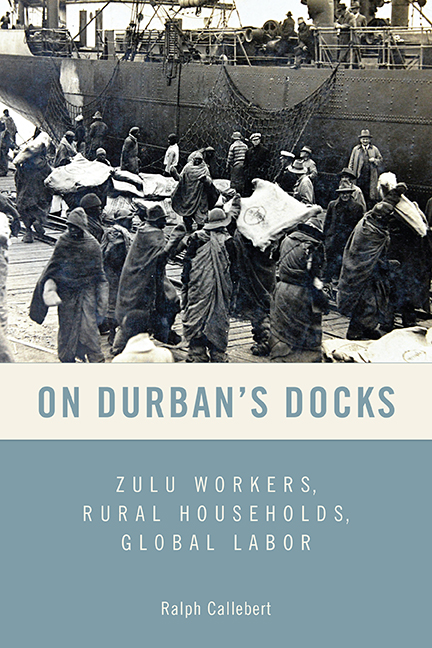Book contents
- Frontmatter
- Dedication
- Contents
- List of Maps
- Acknowledgments
- Abbreviations
- Introduction: Dock Workers in South African History
- 1 Dock Workers and the City, 1910s to 1950s
- 2 One Head of Cattle Named Salt, Another Named Beans: Livelihood Strategies in the 1950s
- 3 Work and Life between the City and the Countryside
- 4 My Children Never Went to Bed Hungry: Gender, Households, and Reproductive Labor
- 5 Cleaning the Wharves: Pilferage, Bribery, and Informal Trade
- 6 Buffaloes on Noah’s Ark: Reimagining Working-Class History
- Conclusion: Durban’s Dock Workers in Global Perspective
- Epilogue
- Notes
- Glossary
- Bibliography
- Index
1 - Dock Workers and the City, 1910s to 1950s
Published online by Cambridge University Press: 29 May 2021
- Frontmatter
- Dedication
- Contents
- List of Maps
- Acknowledgments
- Abbreviations
- Introduction: Dock Workers in South African History
- 1 Dock Workers and the City, 1910s to 1950s
- 2 One Head of Cattle Named Salt, Another Named Beans: Livelihood Strategies in the 1950s
- 3 Work and Life between the City and the Countryside
- 4 My Children Never Went to Bed Hungry: Gender, Households, and Reproductive Labor
- 5 Cleaning the Wharves: Pilferage, Bribery, and Informal Trade
- 6 Buffaloes on Noah’s Ark: Reimagining Working-Class History
- Conclusion: Durban’s Dock Workers in Global Perspective
- Epilogue
- Notes
- Glossary
- Bibliography
- Index
Summary
Durban is known as eThekwini, “at the bay,” to isiZulu speakers. This name reflects the centrality of the harbor to the city's social and economic life. As one of the few accessible natural harbors between Port Elizabeth and Maputo (formerly Lourenço Marques), Durban became South Africa's principal port city and a lynchpin of the regional economy. The city's fortunes have therefore historically been linked to shipping. Accordingly, newspapers, authorities, and local elites have often shown great interest in the development and operation of the port. Dock labor particularly worried them. Dock workers were among the city's biggest concentrations of African workers and are unsurprisingly central to its labor history. As casual laborers, they were a major preoccupation for authorities who were perpetually concerned with control over African populations. This chapter sets the scene for the rest of this book. It situates dock laborers within the history and political economy of the province and the region, and within the labor market and political scene of Durban.
Migrant Labor
Like many African laborers in southern Africa, Durban's dockers were migrant workers. The system of oscillating labor migration meant that workers retained their rural homesteads and migrated to the cities or mines as single males, leaving their families behind sometimes for a year at a time. Authorities and mine owners, southern Africa's most influential employers, often actively promoted this migrant labor system or even had a hand in establishing and organizing it. Scholars have extensively debated the origins of migrant labor. Liberals stressed the attractions of the city: the excitement of urban life, modern luxuries and conveniences, and higher wages. Jan Smuts, who was twice prime minister of South Africa, exemplifies this bright lights theory in his 1936 foreword to Monica Hunter's Reaction to Conquest: “Johannesburg, with its glittering prizes (on native standards) in wages, the fantastic excitements of its large vivid life, its opportunities of larger more adventurous experience, the prestige of familiarity with the great unknown which attaches to those who have returned from employment there—Johannesburg has become a sort of Mecca of the native, and quite the biggest factor of change to the native all over Southern Africa. It has profoundly disturbed the ancient immemorial life of Africa.”
- Type
- Chapter
- Information
- On Durban's DocksZulu Workers, Rural Households, Global Labor, pp. 20 - 45Publisher: Boydell & BrewerPrint publication year: 2018

